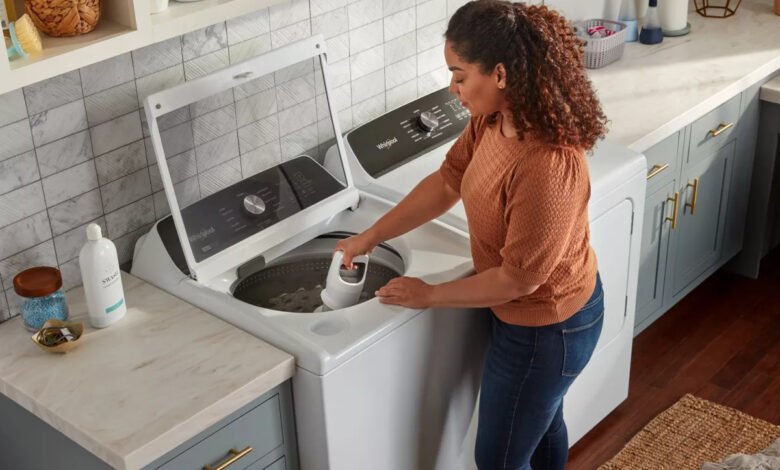How to Repair Agitator on Whirlpool Washer

In the world of laundry appliances, the Washing Machine Agitator plays a crucial role in ensuring effective cleaning by creating a dynamic water flow. When faced with issues in your Whirlpool washer’s agitator, it’s essential to address them promptly to maintain the efficiency of your machine. In this comprehensive guide, we, as seasoned experts in washer repair, will take you through the process of repairing the agitator on your Whirlpool washer, leaving no stone unturned.
What a Washing Machine Agitator Is?
Before delving into the repair process, let’s understand what a washing machine agitator is. The agitator is a central post in the middle of the washer drum that moves and rotates during the wash cycle.
Its purpose is to create a motion that assists in dislodging dirt and stains from your clothes. In Whirlpool washers, you may encounter two types of agitators: the spiral agitator and the dual-action agitator.
The spiral agitator has fins that extend from the bottom to the top, while the dual-action agitator has a top section that moves independently of the bottom.
Identifying Agitator Problems
Common issues include erratic movements, failure to spin, or strange noises during operation. According to Jacob Dillard, a leading technician at Appliance Repair Expert, the following signs are crucial to identifying agitator problems with a Whirlpool washer:
- Erratic Movements: If the agitator’s motion seems unpredictable or irregular during the wash cycle, it could indicate an underlying problem.
- Failure to Spin: A malfunctioning agitator might struggle to spin properly, leading to incomplete washing cycles.
- Strange Noises: Unusual sounds during the wash cycle, such as grinding or clunking noises, can signal agitator issues that require attention.
These signs provide valuable insights into the health of your washer’s agitator.
Tools You’ll Need
Equipping yourself with the right tools is crucial for a successful repair. Here’s a detailed list of tools and their purposes:
- Wrenches: Use wrenches to loosen and tighten nuts, bolts, and screws during the disassembly and reassembly of the washer components.
- Screwdrivers: Screwdrivers come in handy for removing screws securing various parts of the washer. They are essential for opening panels and accessing internal components.
- Pliers: Pliers are versatile tools useful for gripping, twisting, and manipulating different components. They assist in tasks like removing the agitator cap and handling small parts.
- Replacement Agitator Kit: If the agitator is irreparable, having a replacement agitator kit is crucial. Follow the manufacturer’s instructions for a seamless installation of the new agitator.
Troubleshooting Whirlpool Washer Agitator
Safety Considerations
Before initiating any troubleshooting or repair procedures, it’s paramount to prioritize safety. Unplug the washer from the electrical outlet to eliminate the risk of electrical shocks. Additionally, wear appropriate personal protective equipment, such as gloves and safety glasses, to safeguard against any potential injuries during the repair process.
How to Remove the Agitator?
Step 1: Unplugging the Washer
Safety is paramount. Before any repair work, disconnect the washer from the power source to eliminate the risk of electrical accidents.
Step 2: Removing the Agitator Cap
Commence the repair by removing the agitator cap, usually situated at the top of the agitator. Depending on your model, use a wrench or your hands. This exposes the agitator bolt, which needs to be loosened for further disassembly.
Step 3: Loosening the Agitator Bolt
With a wrench, carefully turn the agitator bolt counterclockwise to detach it. Apply steady force, ensuring a secure grip on both the wrench and the agitator. This step is pivotal for accessing the internals of the agitator.
Repair or Replacement
- Inspecting the Agitator. Once the agitator is disengaged, inspect it thoroughly. Look for visible damages such as cracks, breaks, or worn-out fins. Each detail matters in determining the appropriate course of action.
- Repairing Small Damages. For minor damages like small cracks, employ a strong adhesive suitable for plastic to mend the agitator. Adhere strictly to the manufacturer’s recommendations to ensure a durable repair.
- Replacing the Agitator. If the agitator proves irreparable, it’s time for a replacement. Use a new agitator kit, adhering precisely to the manufacturer’s instructions for a seamless installation.
Conclusion
Repairing the agitator on your Whirlpool washer is a task that demands precision and attention to detail. By following this comprehensive guide, you equip yourself with the knowledge to troubleshoot and address agitator issues effectively. Remember, safety always comes first – unplug the washer before attempting any repairs.







